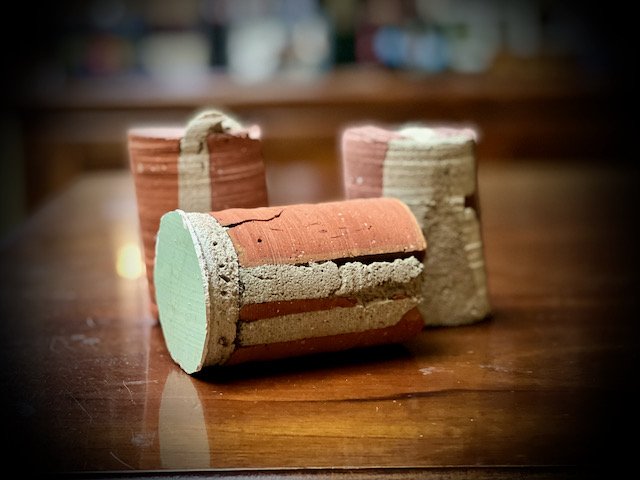My most valued collection is nothing but worthless rocks
I have an odd collection of rocks on the bookshelf in my office. Among the collection are a jagged chunk of concrete, two broken bricks, three red cylinders cut from a brick wall, and a large cement cylinder cut out of a floor.
The first of the collection is the large cement cylinder. It stands about 4 inches tall. The sides are smooth from the blade that cut it. The smooth sides reveal the rock and rebar that were once part of the first floor of Roberts Hall, a men’s dormitory on the Rome, GA campus of Shorter University. During my sophomore year of college, the building was being wired for a new campus phone system and computer network. To provide access to each floor for the needed wiring, holes were drilled through the concrete floors. The new phone system was rendering the payphones on each floor obsolete, so their closets made convenient spaces through which to run the new wiring. The payphone closet was adjacent to the place at the end of the hallway, where I would often go late at night to read scripture and pray. The circular coring blade that cut through the concrete produced smooth-sided cement cylinders that the workmen left on the floor when they finished. One night, as I was reading scripture and praying, I noticed the forsaken remnants of the previous day’s work and decided to take one piece to be a reminder of how the Lord had been so gracious in those days and at that spot to draw me to Himself. It became a treasured reminder to me of God’s grace to convict me of sin and to deepen my obedience to His word.
This first remembrance stone would be the beginning of a collection of stones from places that held significance to me and where God moved in my life. The second addition to the collection were two broken bricks from the front walk of my grandfather’s home. The house had been constructed by my great-grandfather in 1895 and was rather grand for its day. Leading from the road to the front porch steps was a brick walkway. When I collected these two broken bricks, their original red color had faded to a dark reddish-brown. Weathering had left pockmarks on their once smooth sides. The once distinct edges and sharp corners were obscured by the rough and uneven sides suffering the consequences of use and age. The walkway, like the rest of the house, was long past its prime but this home represented part of my spiritual heritage. It was here my mother first heard the gospel. It was here I was able to witness my grandfather’s faithfulness and devotion to God’s word. So, I gathered these two broken bricks as a reminder of how God had shown His grace to me through the generations.
The three red cylinders cut from a brick wall come from the first church I pastored following seminary. These were days made difficult by my naivety and inexperience. While I struggled to balance my role as a pastor, husband, and new father, I experienced many frustrations in those days. I recognized the urgency and eternal significance of the church’s gospel task but did not always appreciate how best to pastor the members toward embracing this task. In this season of maturing and growing, God provided dear friends in the church who cared for us well and dear friends outside of the church who mentored and ministered to us greatly. These three red cylinders, made smooth by the coring blade, remind me of God’s patience and grace toward me in those days. He provided well for us and used these days to prepare and mature me for future days of ministry.
The last addition to the collection (so far) is a jagged piece of concrete. It too came from a concrete floor, however, unlike the piece from my college dormitory, this one was not cut but hammered away from its original place. This piece comes from the second church I pastored. God gave me many years at this church and many dear friends, but there were some difficult challenges as well. A dysfunctional church can, for a while, have a productive ministry, but at some point, the dysfunctions, if not overcome, will rise. Unfortunately for pastors and their families, these dysfunctional dynamics often have grave consequences. The burdens and wounds experienced during this season left their scars on me and my family that remain to this day. In the midst of some of the more difficult moments, I would cry out before the Lord that I was willing to be obedient to His call no matter what. I was determined to be obedient even if that meant remaining and waiting on Him to work in the situation. There were some lonely moments and moments I felt forsaken. Often my prayers were seasoned with tears, pleading for God’s sustaining power. This rock is a reminder that even in hard and jagged places, God is present and will provide sufficiently for your obedience.
These rocks on my shelf, odd though they may be, are my Ebenezers. They remind me when worry and stress threaten to obscure my view of God’s grace, that He is forever faithful. They remind me when pride and arrogance stand in the way of recognizing my weakness and total dependence on the Lord, that I am weak and He is strong. They remind me when sin and rebellion have robbed the joy of my salvation, that if I return to Him, He will return to me. (Zechariah 1:3)
You may be familiar with an old hymn by Robert Robinson titled “Come, thou Fount of Every Blessing,” first published in 1758. In the second verse, Robinson references an event recorded in 1 Samuel 7 with the words, “Here I raise mine Ebenezer; Hither by Thy help I’ve come.” You may have sung these lines without knowing what it means to raise an Ebenezer. In 1 Samuel chapter 4, the Philistines had repeatedly defeated Israel in battle. Trying to find a way to beat the Philistines, Israel thought that if they brought the Ark of the Covenant with them into battle they would prevail. Their plan turned out to be a disaster. They were defeated, with many falling by the Philistine sword. The defeat was so great that the Israelites fled for their lives and left the Ark to be captured by the Philistines.
These were not good days. These were days where rebellion against the commands of God was common, and few had remained faithful to the law of God. Israel was fighting against their foes in their own strength and losing at great cost. The place where these battles occurred was named Ebenezer.
God brought judgment upon the Philistines because they treated the Ark of the Covenant, which was holy before the Lord, with disdain. So great was God’s punishment that they returned the Ark with a guilt offering of gold and animal sacrifices. After these events the prophet, Samuel, called for all of Israel to repent of their sin, put away false idols, and tear down the places of pagan worship. He called them to serve and worship the Lord alone and witness that God alone could and would deliver them.
A national revival broke out. The idols were removed, and the people served the Lord alone. They gathered together, and Samuel prayed a prayer of confession for their sin. The Philistines, hearing that they had gathered in one place, decided to attack their old enemy. But this time, as Samuel prayed, the Lord caused great thunder to erupt, which confused the Philistines so that Israel defeated them and chased them as they retreated. It was a great victory.
“Then Samuel took a stone and set it up between Mizpah and Shen and called its name Ebenezer; for he said, “Till now the LORD has helped us.” (1 Samuel 7:12, ESV)
Samuel erected a stone of remembrance and called it Ebenezer. He knew that Israel would be tempted again to try and use God without serving God. He knew that they would be tempted again to give their hearts to the false gods that the world around them worshiped. So, he raised this stone as a reminder that it was God who was their deliverer. He raised the stone to remind them when time and distance had dulled their remembrance of the despair that resulted from their sin, that help and deliverance was not from their hand or the pagan gods but singularly from the one true God.
I encourage you to raise your own Ebenezers. If you do, you will be in good company. Like Samuel raising the Ebenezer stone (1 Samuel 7), Joshua before him, who led the people across the Jordan River into the promised land, had twelve stones taken from the middle of the river and placed as a sign of remembrance of God’s deliverance (Joshua 4:1-8). Raise your Ebenezers that you too may be reminded that no matter where, or how, or how far you may go, God alone is your “refuge and strength, a very present help in trouble.” (Psalm 46:1) Be reminded that He is your deliverer and strong tower (Psalm 61:3, Proverbs 18:10). Be reminded that He is your redeemer and Lord (Isaiah 43:14; 44:6; 49:7, 26, 54:5; 59:20; 60:16; 63:16; Psalm 19:14). And be reminded that if you are to do anything of eternal significance, you must rely on God alone.















Last week, the Southern Baptist Convention held its Annual Meeting. Gathering in New Orleans, LA, there were nearly 19,000 in attendance. Of these, 12,737 were registered messengers (messengers are similar to delegates) from 4,423 churches. During the two days of meetings, the messengers worked through a packed schedule that included changes to the doctrinal statement of the Convention and a constitutional amendment, among many other things. Southern Baptists are unique in that we have our debates over critical issues in public with the opportunity of any registered messengers to speak. This does not always make for flattering soundbites in the news and sometimes leads outside observers to think that we are contentious and in constant conflict. For those who attend the meetings and participate in the decisions, even in greatly debated issues, we generally depart the annual meeting more encouraged in the work and cooperation of the SBC. Below are some of the more significant decisions of the messengers to this year’s annual meeting.